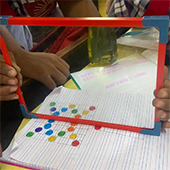Design Case study
Design in Schools
Applying design thinking to teach mathematics concepts in early education
by
Design process that was followed in this project:
• Introduction
• Aim and Objectives
• Scope
• Deliverables
• Methodology
• Motivation
• Positioning
• Literature Review
• Design Thinking in Pedagogy
- Adapting the Design Thinking in DTI Curriculum
• Understanding the Learning Theories in Education
• Understanding the Learning Models in Education
- Multiple Intelligences by Howard Gardner
- Bloom’s Taxonomy
- Kolb’s Cycle
• Summary in Implications for Pedagogy
• Teaching of Mathematics
- Change in Learning Pedagogy
- Works of George Polya
- Works of Jean Piaget: Discovering Space, Time, and Numbers
- Works of Jerome Bruner
- Mathematics Games and Activities
• Existing Knowledge with Students
• Primary Research
- Part 1: Interactions with Teachers and Observing the Teaching
- Environment
- Problems Identified and Observed
- Different meaning of Concept
- Part 2: Conducting Teaching Classes and Pilot Study
- Sessions Plan
- Observations and Results
- Learnings and Limitations identified from Pilot Study
- Feedback and moving forward in the project
• Redesigning the Sessions
- Structuring of Classes
- Topics and Concept Selection
- Features of Lesson Plans
- Content of the Lesson Plan
- Lesson Plan: Patterns & Mirror Symmetry
- Lesson Plan: Fun with Numbers
• Evaluation Plan
- Expert Evaluation
- Evaluation of Lesson Plan by teaching Students
- Conducting the Pre-Test
- Teaching Methodology
- Qualitative Observations
- Student Reflection for Symmetry and Mirror Images
- Some other observations for Place Value and Numbers
- Feedback given by the teachers who assisted me while teaching
- Quantitative Results
• Development of Detailed Lesson Plan
- Defining the Session Planning and Guidelines
- Features of the Lesson Plan
- Features of the Activity Workbook
• Evaluation on Final Lesson Plan
• Project Limitations
• Future Steps
• Conclusion
• Reflection
• References
• Appendix 1 (Detailed Evaluation Results)
Case Study Download:
• Design in Schools_Report......





































































